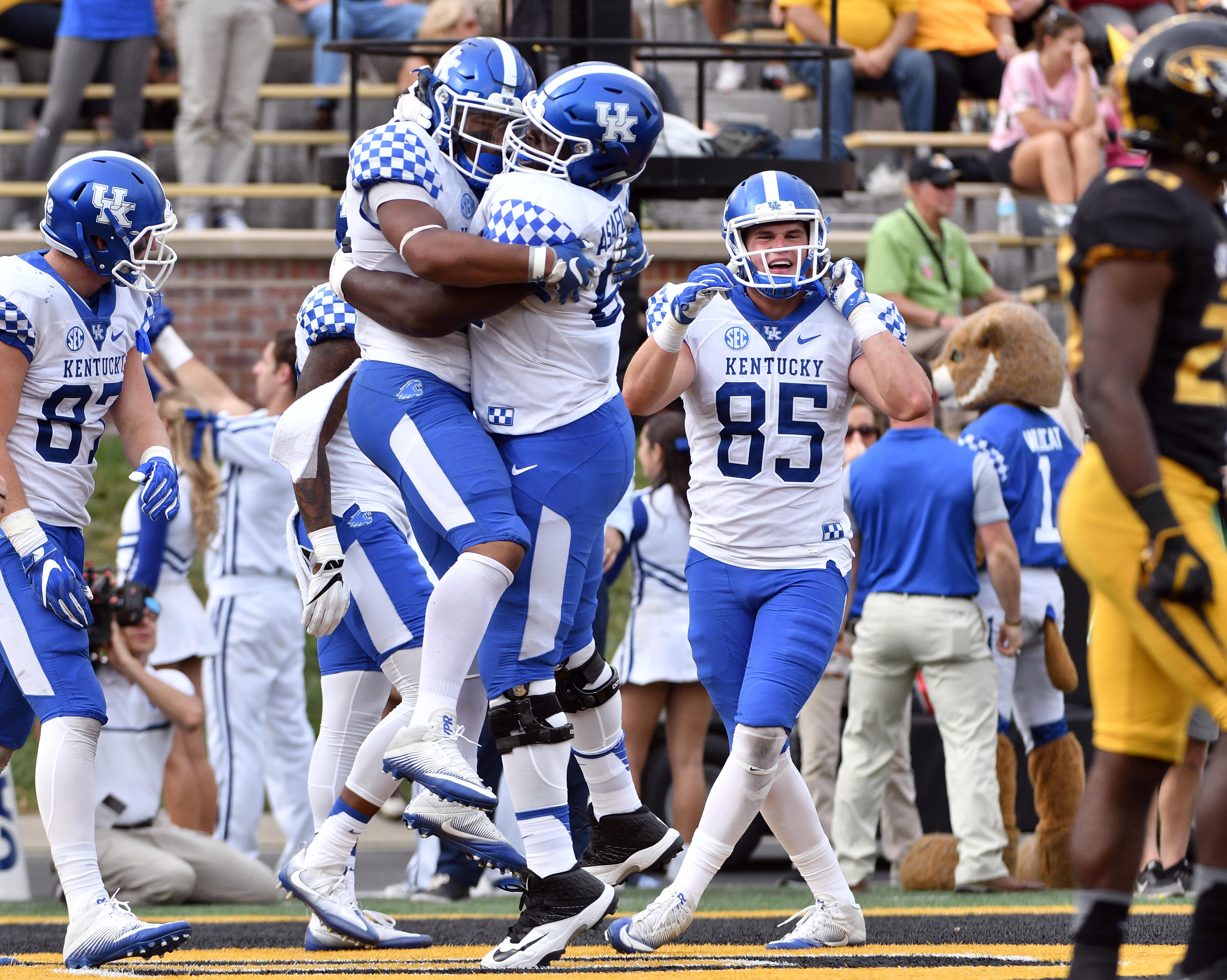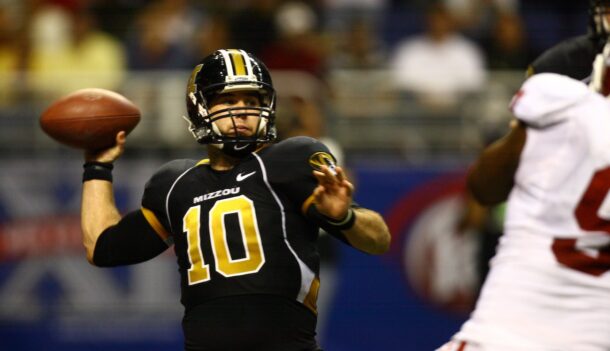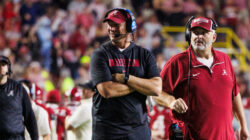
Kentucky’s offense has a chance to be even better in 2017. Here’s why
By Joe Cox
Published:
Kentucky’s improvement from SEC East bottom-feeders to competitors in 2016 was keyed mostly by the Wildcats’ surprising offense.
After a devastating injury to starting QB Drew Barker ended his season during the first series of the team’s third game, Kentucky’s offense — and probably its entire program — looked hopeless. But dual-threat JUCO transfer Stephen Johnson revitalized the attack, and the program’s first pair of 1,000 yard, single-season rushers (now-departed junior Stanley “Boom” Williams and true freshman Benny Snell) enabled UK to churn out enough production to win games.
Benny Snell finished tied for third in the SEC with 13 rushing TDs in 2016.
Kentucky averaged 30 points per game (9th in the SEC) and averaged just over 420 total yards per game, which was 10th in the league but just 8.3 yards from 8th. That 420 yards was also third-best in the East, behind Missouri and Tennessee. Kentucky excelled on the ground, totaling 234.2 rushing yards per game, placing the Wildcats third in the conference, improbably between Alabama and LSU.
One area Kentucky will look to continue its improvement is in the passing game. Johnson was inconsistent, connecting on just 54.7 percent of his throws. The Wildcats were 13th in the SEC in passing yardage, leading only Auburn.
The good news was that Kentucky was a respectable 8th in pass efficiency — and that might translate into 2017, as Kentucky might be less concerned about piling up statistics than being efficient enough to keep winning.
This is particularly true in the SEC, where Kentucky’s 4-4 mark could be equaled fairly easily as the Wildcats will match up against the SEC’s bottom three scoring defenses from 2016 among their eight league foes.
Running game
Kentucky’s versatile and deep offensive line paved the way for explosive seasons from Williams, who rushed for 1,170 yards on 6.8 yards per carry, and Snell, who finished with 1,091 yards, including 13 touchdowns, which set a school freshman record.
Williams made an ill-advised decision to enter the NFL Draft and was not selected. He signed as an undrafted free agent with Cincinnati. Snell returns, and Kentucky is auditioning candidates like junior Sihiem King (11 carries for 81 yards in 2016) and redshirt freshman A.J. Rose to try to fill Williams’ shoes.
Kentucky lost starting center Jon Toth, but returns the other major components of its line. While there will be questions about replacing Williams and dependable third back Jojo Kemp (349 yards and 6 TDs in 2016), Kentucky is in good shape here.
Had Williams returned, it might have been the most talented backfield in recent UK memory. It still stands to be a team strength, although more than ever will be resting on the powerful legs of Snell, who is a bruising physical runner whom the ‘Cats will have to keep healthy.
Quarterback
Despite attempts to manufacture a controversy, Johnson will be a significant favorite to be starting QB in 2017. Despite playing minimally in the season’s first two games, he finished 2016 with 2,037 yards passing and 13 touchdowns against six interceptions. The x-factor that the senior adds to the team is his 327 rushing yards and three scores on the ground.

Johnson does not always play a pretty game. He struggles to complete mid-range passes, and had some significant issues with fumbles. But he throws a remarkably catchable deep ball, and seemed to encourage his team substantially as 2016 wore on.
In a memorable performance against in-state rival Louisville, Johnson outplayed Heisman Trophy winner Lamar Jackson with 338 yards passing and 3 touchdowns, and worked the Wildcats into range for the game-winning field goal in the closing seconds.
If Drew Barker can play, which is far from a given after a career-threatening back injury and subsequent surgery, he would bring a different skill set as a pocket-passer. If Barker can’t play, the other option is redshirt freshman QB Gunnar Hoak, who was impressive in Kentucky’s spring game either with the second-team or first-team offense.
Kentucky has more depth than normal, especially if Barker can play. The natives might get restless with Johnson, but he’ll get the first crack in 2017 — and probably the last one.
Receivers
Despite the team’s steady improvement, top target Jeff Badet transferred to Oklahoma … where his potential coach has just retired. That sort of decision making has been about par for the course for the UK receivers, who have struggled in just about every way imaginable.
Senior-to-be Dorian Baker was the top returning target from 2015 but struggled with injuries early in 2016 and ended up with 14 receptions for the season. Badet was a home-run threat (averaging 21.6 yards per catch), but had major struggles with dropped passes.
There is talent — senior Garrett Johnson (39 catches, 585 yards, 5 TDs) is a valuable slot receiver, and tight end C.J. Conrad (19 receptions, 262 yards, 4 TDs) is a viable All-SEC candidate if Johnson can get him the ball more frequently. Baker and freshman Tavin Richardson are two viable deep threats. True freshman Lynn Bowden is a multi-purpose player who might end up starring at receiver.
This unit is something of a question mark entering 2017.
Red zone
The red zone was a strength in 2016, between Johnson’s dual-threat capabilities and Snell’s ability to churn through tackles. Kentucky converted 25 of 42 red-zone opportunities into touchdowns, which in the middle of the pack in SEC totals. Including 11 field goals, UK ended up scoring on 85.7 percent of its red zone possessions, which was 4th-best in the SEC.
Other than Jon Toth at center, Kentucky’s personnel losses really shouldn’t hurt in this area. It would not be surprising for the touchdown percentage to trend upward in 2017, and with senior kicker Austin MacGinnis still in Lexington, short field goals should be a secure proposition.
Better or worse in 2017?
Kentucky’s offense was deceptively powerful in 2016.
There were games when the Wildcats put together just enough yardage to survive, like a 351 total yard effort in a 17-10 win over South Carolina, or an ugly win over Vanderbilt when Stephen Johnson passed for only 49 yards.
But UK also eclipsed 350 yards rushing three times, nearly setting a school record by rushing for 443 yards at Tennessee.
Ball control will be pivotal for UK in 2017. Stephen Johnson didn’t throw many interceptions last year, but he did lose the football at inopportune times, which could prove costly. Snell has shown durability and ball security, but whoever will replace Williams in the Thunder-and-Lightning duo will have to do the same.
Consistency will be pivotal in Kentucky’s passing game. If Johnson can put more of his mid-range throws on target and Kentucky’s receivers do a better job of finishing plays, the team could well move ahead in both yardage and scoring from their 2016 totals.
It is a very rare thing to see a team plan toward one specific style of play and then turn on a dime in the season’s third game into a completely different system. But that was what Kentucky did in 2016, and it stands to reason that another year of continuity could keep their program moving in the right direction.
Ultimately, things look better for the UK offense in 2017.
Joe Cox is a columnist for Saturday Down South. He has also written or assisted in writing five books, and his most recent, Almost Perfect (a study of baseball pitchers’ near-miss attempts at perfect games), is available on Amazon or at many local bookstores.







